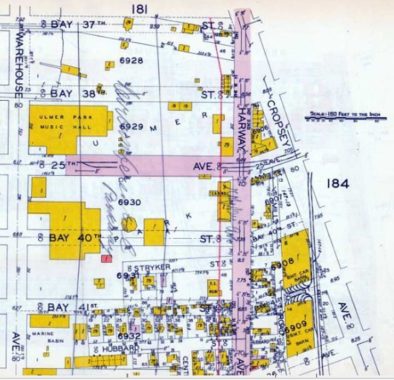A look at a modern-day map shows Cropsey Avenue, the main artery of Bath Beach, make a sharp southward turn at about 24th Avenue, crossing Coney Island Creek over a drawbridge to Neptune Avenue, where it meets West 17th Street. Meanwhile, Harway Avenue branches off it to continue southeast to Stillwell Avenue; for many years, the B64 bus has ran on it instead of Cropsey. That avenue is named for German immigrant Casper Cropser, whose name was Anglicized for English tongues. Descendants of his are the painter Jasper Cropsey, who painted some Staten Island scenes as well as upstate Hudson River views. Harway Avenue is named for 19th Century developer James Harway.
Cropsey Avenue made that curve because it originally ran on a short peninsula between Gravesend Bay and the vanished Harway Basin, since eliminated by landfill. This area was once part of small towns called Unionville and Guntherville, as indicated on FNY’s Mill Road page.
Shown above is the state of things in 1929. Some of Unionville’s original roads, such as Stryker Street and Hubbard Street, are still in place. Only the roads shown in purple were paved at the time, however.
The biggest change made in the area — other than its landfilling and urbanization, of course — to my mind is the great Cropsey-Harway Shift. On this map, it is Harway Avenue that makes the curve and is the main drag through the region, plunging south to Coney Island Creek. And, it is Cropsey that is mapped to head southeast to meet Stillwell Avenue. Sometime between 1929, and my next oldest map from 1938, the two avenues trded names. The question is, when exactly and why?
If anyone can provide an answer…comment below as you see fit.
12/15/17
